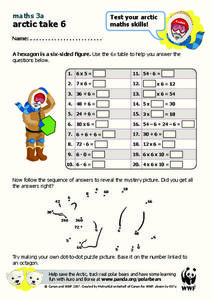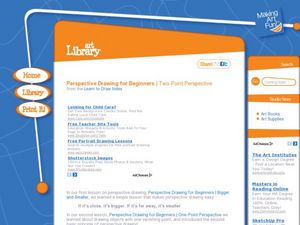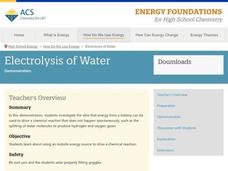Curated OER
Organic Chemistry Problem Set Exam 1
Though there are technically only 13 questions on this exam, they take up six pages and make a thorough assessment of organic chemistry principles. There are plenty of diagrams to label or complete. Emission spectra are displayed for...
Curated OER
Ranking Molecular Properties Based Upon Intermolecular Forces
A splendid chart of information about chemical bonding tops the first page. In it you will find information on London forces, permanent dipoles, hydrogen bonds, ionic bonds, and covalent bonds. A four-step process for assigning...
Curated OER
Find the Rhyme
Which of these objects rhymes? There are four starter pictures here, each heading rows of three objects. Learners determine and circle the row object that rhymes with the first one. Then, they connect two of the CVC words with printing...
World Wildlife Fund
Arctic Take 6
The magic number is six! Using a 6x table, young math stars practice adding, subtracting, multiplying, and dividing two-digit numbers with the number six. This learning exercise also touches on making tessellations with hexagons.
Curated OER
Find the Rhyme
Find the rhyming word. All of these rhyming, single-syllable words have the short i sound, but learners have to determine which ones they are. There are four starting objects each heading a row of three objects. They examine the...
Curated OER
Odd Ones Out
Some of these words don't rhyme; scholars determine which ones as they examine four sets of images with the vowel sound /e/. For each set, they circle the words that don't rhyme with the first image. Be sure kids know what these images...
Curated OER
Match the Rhymes
Which ones rhyme with swing? There are six images and scholars determine which ones rhyme. Two of the words are written out below to incorporate some printing practice as scholars trace the letters to form each single-syllable word....
EngageNY
Even and Odd Numbers
Even or not, here I come. Groups investigate the parity of products and sums of whole numbers in the 17th lesson plan in a series of 21. Using dots to represent numbers, they develop a pattern for the products of two even numbers; two...
Curated OER
Chemical Formula Practice #1/Bonding Basics Practice Page
The first of two worksheets methodically prepares chemistry novices for naming polyatomic compounds. It begins by having them acknowledge the number of each atom contained in a molecule. Then learners list the valence electrons for a...
Curated OER
Find the Rhyme
Which one rhymes? There are four starting objects here, each heading a row of three objects. Learners identify the objects and their vowel sounds to determine which one rhymes with the first object. All these rhyming words involve the...
Curated OER
Hopping by 2s, part 2
Explore skip counting by twos with young mathematicians as they complete these engaging activities. First, they color in squares to represent counting by twos in an even sequence and an odd sequence. Next, they connect dots (by twos) to...
Curated OER
Maniac Magee Comprehension Questions
Supplement your Maniac Magee lesson plans with a packet of student materials. Included here is a variety of questions about the text. Pupils complete multiple choice and short-answer questions and choose from a variety of extension...
Statistics Education Web
Using Dice to Introduce Sampling Distributions
Investigate the meaning of a sample proportion using this hands-on activity. Scholars collect data and realize that the larger the sample size the more closely the data resembles a normal distribution. They compare the sample proportion...
Physics Classroom
Acceleration
The acceleration rate of a flea jumping works out to 50 times faster than the acceleration rate of the space shuttle. Pupils apply knowledge of acceleration to dot diagrams, velocity-time tables, and word problems. They solve for...
Curated OER
Counting Numbers in Sequence 1-41
In this counting numbers in sequence worksheet, students follow the dot to dot to create a picture. In this drawing worksheet, students connect forty numbers.
Curated OER
Bumblebee Dot To Dot
In this science worksheet, 2nd graders will complete a dot to dot. Students will connect the dots from one to thirty-one to create a flower for the bumblebee.
Curated OER
Perspective Drawing for Beginners-Two Point Perspective
Students inspect two point perspective. In this perspective instructional activity, students explore drawing with two vanishing points. Students create an original piece of art using two point perspective.
Curated OER
What is the Cat Looking For?
In this addition worksheet, learners answer 10 fill in the blank questions where they rewrite number sentences to use the making ten strategy. Then students use the answers to solve a connect the dot puzzle.
University of Minnesota
Blind Spot
Your eyes each work independently, so how do we only see one image? The quick hands-on experiment encourages young scientists to test their blind spots on each eye individually. After learning where the blind spot is and why it exists,...
American Chemical Society
Electrolysis of Water
Young scientists know that water is H2O, but can they prove it? Through a simple electrolysis of water demonstration, scholars see the two gases produced as a result of a chemical reaction. Because this reaction doesn't happen...
Ascanius: The Youth Classics Institute
Anatomy and Simple Commands
Poor Joe is all in pieces, and he needs students to learn the Latin words for his body parts so that they can put him back together! Learners work as a class first to perform whole-body reconstruction, and then individually. In addition,...
Super Teacher Worksheets
Counting Memory Match Game
What a fun way to practice counting! Print these cards for an easy go-to matching game. Partners take turns playing a memory game, flipping the cards over to try to match a number with the card that has the corresponding number of...
Curated OER
Wagon 1-5
In this dot-to-dot activity, students connect the dots numbered 1-5 to finish a picture of a cat sitting and smiling in a wagon.
Curated OER
Alphabet Letters Dot-to-Dot Puzzle
In this alphabet letters instructional activity, students will connect the numbered dots in sequential order, 1-14 or 1-17, to create both an upper and lower case version of a letter in the alphabet.























